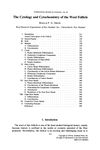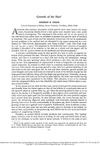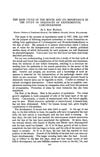TLDR EGF and FGF help hair growth by affecting cell differentiation and fiber growth.
The study explored the roles of epidermal growth factor (EGF) and fibroblast growth factor (FGF) in hair growth induction, focusing on their expression and localization in sheep skin. EGF receptors were found on skin epithelia, and an EGF-like protein was detected in fetal epidermis but not in developing wool follicles, later associating with sebaceous glands and the outer root sheath (ORS). This suggests EGF may influence cell differentiation in the ORS. FGF was found in the epidermis, basal lamina, and follicle plugs during morphogenesis, and later in the ORS and follicle bulb, indicating a role in bulb proliferation and fiber growth.
193 citations
,
June 1990 in “Journal of Investigative Dermatology” 114 citations
,
September 1985 in “Journal of Investigative Dermatology” 112 citations
,
August 1984 in “Journal of Investigative Dermatology” 124 citations
,
December 1983 in “Developmental Biology” EGF receptors are crucial for skin cell growth and decrease with age.
72 citations
,
January 1983 in “The Anatomical Record” Epidermal growth factor delays skin and hair development in mice.
84 citations
,
February 1981 in “Journal of Endocrinology” Epidermal growth factor slows hair and body growth in mice.
 90 citations
,
January 1979 in “International review of cytology”
90 citations
,
January 1979 in “International review of cytology” Wool follicles are complex, involving interactions between different cell types and structures.
 521 citations
,
January 1954 in “Physiological Reviews”
521 citations
,
January 1954 in “Physiological Reviews” Hair growth is cyclic and influenced mainly by local factors.
 111 citations
,
March 1951 in “Annals of the New York Academy of Sciences”
111 citations
,
March 1951 in “Annals of the New York Academy of Sciences” Understanding the mouse hair cycle is crucial for cancer research.
 45 citations
,
May 2003 in “Journal of Cell Science”
45 citations
,
May 2003 in “Journal of Cell Science” α3β1-integrin is crucial for maintaining normal hair follicle shape and function but not needed for the development of the surrounding skin.
3 citations
,
July 1990 in “PubMed” Human hair follicles can grow and form structures in a collagen gel, useful for studying hair cell growth.
13 citations
,
December 1983 in “Canadian journal of zoology” Heterotypic cell contacts likely help hair matrix cells differentiate during mouse hair follicle development.
59 citations
,
August 1981 in “PubMed” Trichilemmal keratinization is a unique process in hair follicles where the outer root sheath turns into keratin without a specific layer.





